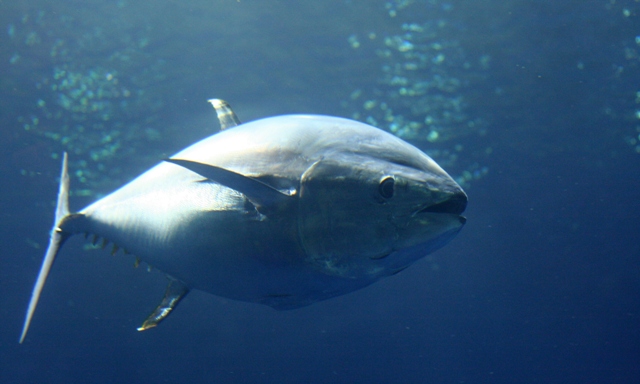"Aquaculture, not the Internet, represents the most promising investment opportunity of the 21st Century."
- Peter Drucker, Management Expert & Economist
- Peter Drucker, Management Expert & Economist
2016-06-02Japanese Farms Boosting Bluefin Tuna Farming |
International regulations on tuna fishing are becoming increasingly strict in the midst of further concerns over declining tuna stocks and overfishing. Amidst this, companies in Japan are turning to bluefin tuna farming, with at least two market leaders moving ahead in aquaculture development. Sojitz, established in September 2008 as Sojitz Tuna Farm Takashima Co., Ltd, was the first major trading company in Japan to invest in the tuna farming business. A key trader in the field of imported frozen tuna for sashimi, Sojitz launched its farming business after feeling a sense of crisis over increasingly tight fishing regulations. "We must provide a stable supply of aquatic resources such as tuna," said Junya Hanazawa who was in charge of the project when it was first established. "To do this, we, and other trading companies, should be promoting fish farming." Today, Sojitz's farming site lies 500m offshore of Matsuura City in Nagasaki prefecture, southern Japan. The tuna are fed blue-skinned fish such as mackerel and sardines caught by purse seine fishing, while the strong current and low water temperatures (around 12°C) observed in winter help produce fish with firm flesh and a lot of fat on the skin. Sojitz is not the only company in Japan with its eye on bluefin tuna farming. Food maker Nippon Suisan Kaisha, or Nissui, is currently studying how to farm bluefin by artificially hatching eggs or fattening juvenile fish to maturity. This research is still in its early stages but soon the technique could be perfect. Nakatani Suisan Co., Ltd has gone a step further, purchasing young fish caught in July and August from fishermen operating in the Pacific Ocean off the island of Shikoku, and off the Oki Islands in the Sea of Japan. These fish are then reared in taming fish cages for around 2 months before being transported to farming fish cages when they weigh about 500g. Here, they are farmed for 2-3 years until they weigh around 50kg, under various monitoring systems such as daily measurements of water temperature and dissolved oxygen concentration to determine the amount of feed and to control farming conditions. While aiming to beef up production in future, Nakatani Suisan is researching formula feed and hoping to build cooperative relationships with relevant departments, group companies and wholesalers. Meanwhile another firm, Maruha Nichiro, began full-fledged shipments of fully farmed bluefin this year, and is aiming to sell not just to wholesale markets but also directly to other channels, such as overseas restaurants with Japanese cuisine on their menus. In summer last year, the company joined forces with Japan's major supermarket chain Aeon, and is currently offering direct seasonal tuna shipments to the firm. In 2010, Maruha Nichiro also became Japan's first private sector corporation to succeed in the fully closed life-cycle aquaculture of bluefin, and acquired Japanese Agricultural Standards (JAS) certification for food traceability, allowing their farmed tuna to be sold with the JAS symbol at retailers that satisfy certain conditions. The certification also requires the company to publish data on farmed tuna such as where they came from originally and what they were fed. Other firms have formed partnerships with university institutions. Trading house Toyota Tsusho is working with Kindai, or Kinki University, to mass-produce bluefin, and is aiming to sell 240 metric tonnes, mainly to department stores, by 2020. It's also hoping to raise the bluefin's survival rate to 70% and boost the percentage of fully farmed bluefin on the market in Japan to around 5%. Kindai, meanwhile, hit the headlines after becoming the first in the world to succeed in the farming of bluefin - something that was believed to be an impossible task. In 2014 Kindai and Toyota Tsusho signed a memorandum of understanding on jointly promoting business in marine product cultivation, including the production of bluefin hatchlings, with the aim of contributing to the expansion of sustainable marine-product cultivation. Work between the two entities has been underway since 2010 with two tuna farms currently in operation, but a Toyota Tsusho subsidiary opened a bluefin nursery centre in Nagasaki in 2015, where bluefin fry are produced through artificial incubation. The centre is also involved in a bluefin tuna intermediate breeding business, working to increase survival rates and reducing the risk of fish fry dying during transport. But can farmed tuna save the bluefin from extinction? As promising as farmed bluefin sounds, so far it's proven to be extremely difficult to achieve. For one thing, bluefin have extremely delicate bodies, making it hard to catch them. Once the young mature, they start swimming dangerously fast and can easily run into a net and die. They also consume a lot of food -- 250 bluefin, each weighing around 100kg, require a total of around 1 tonne of frozen mackerel each day. Farming bluefin is still very much a work in progress, but some say that there is no need to differentiate between wild species and farmed stocks. In other words, it's about co-existing, and through aquaculture it's possible to continuously look into new ways to improve the production of bluefin. Further resource surveys have suggested that international regulations could become even tighter. This means that the demand for fully farmed bluefin is expected to go up even more, leading to stronger and more intense competition.  Reproduced with permission. Copyright: www.thefishsite.com |
| < Tilbage til efterretninger |